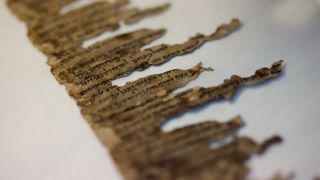Tatyana Bitler, conservatrice à l'Autorité israélienne des Antiquités, montre des fragments de manuscrits de la mer Morte, dans un laboratoire à Jérusalem, le 2 juin 2020
afp.com - MENAHEM KAHANA
Amigo Alexandre H.Gruszynski enviou a notíci8a. Obrigado
Certains des manuscrits de la mer Morte, collection de textes millénaires incluant le plus ancien texte biblique en hébreu, ne viennent pas du désert où ils ont été retrouvés, conclut une étude rendue publique mardi sur l'ADN de fragments de ces parchemins.
Les 900 manuscrits retrouvés entre 1947 et 1956 dans les grottes de Qumrân, au pied de la mer Morte, en Cisjordanie occupée actuelle, sont considérés comme l'une des plus importantes découvertes archéologiques de tous les temps car ils comprennent des textes religieux en hébreu, en araméen et en grec, ainsi que la plus ancienne version de l'Ancien Testament connue.
.....................
]
Ancient DNA Yields New Clues to Dead Sea Scrolls
A sensitive genetic fingerprinting technique could help scholars learn more from thousands of fragile parchment fragments
- By Josie Glausiusz on

The scenario might sound like the opening line of a science-themed comedy routine: a molecular biologist and a Bible scholar meet on a bus. Eight years after that encounter the two have developed a new technique using DNA sequencing that they say will enable them to match—or separate—minuscule fragments of the 2,000-year-old Dead Sea Scrolls. Their research was published on Tuesday in Cell.
Oded Rechavi investigates inheritance in the nematode worm Caenorhabditis elegans, and Noam Mizrahi studies ancient Hebrew literature. Both researchers are at Tel Aviv University, and in 2012 they sat beside each other on a bus during an orientation program for new faculty hires. United by a common interest in worms (“Oded works on microscopic C. elegans worms, and I’m working on what worms have left us," Mizrahi quips), the pair subsequently decided to collaborate.
**********************************

**********************************
Ancient DNA could reveal full stories on the Dead Sea Scrolls
The Dead Sea Scrolls are made up of 25,000 fragments that researchers are trying to piece together.

Fragments of the dead sea scrolls photographed in a lab in Jerusalem, Israel in 2012.
(Image: © Uriel Sinai/Getty Images)
The Dead Sea Scrolls are made up of tens of thousands of manuscript fragments — mostly made of parchment, or animal skin. Now, scientists are analyzing tiny traces of ancient DNA in these fragments to piece together the story of the early text.
In the 1940s, the first of the Dead Sea Scrolls, which date back 2,000 years, were found in a cave near the archeological site of Qumran in the West Bank, on the northwest shore of the Dead Sea, Live Science previously reported. Since then, fragments of the scrolls have been found scattered across 11 caves near Qumran and a couple of other sites in the Judean desert. Still others have been found in the collection of antiques dealers.
Archaeologists currently have more than 25,000 of these fragments, which once made up a series of 1,000 ancient manuscripts. The scrolls include early copies of the Hebrew Bible, calendars, astronomical text and community rules, and even contained information on the location of buried treasure, Live Science previously reported. Since researchers first discovered these fragments, they have been trying to piece them together to understand the full story of the scrolls.

No comments:
Post a Comment